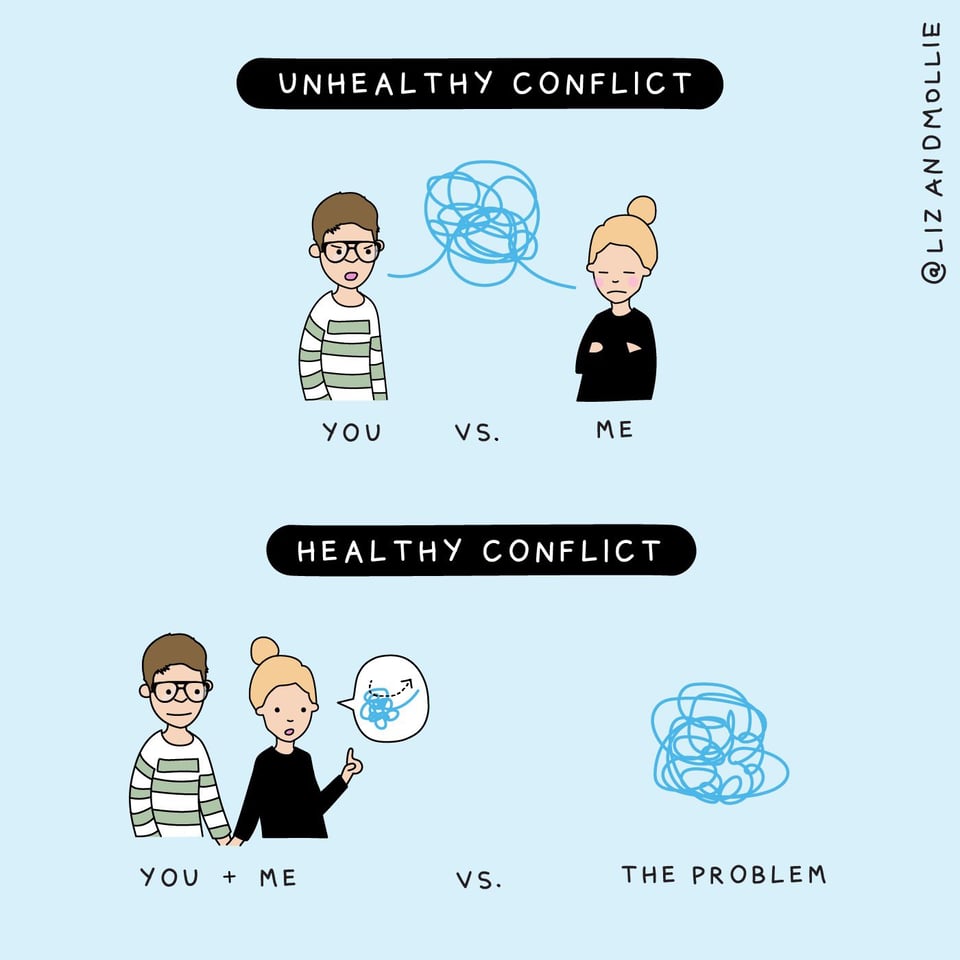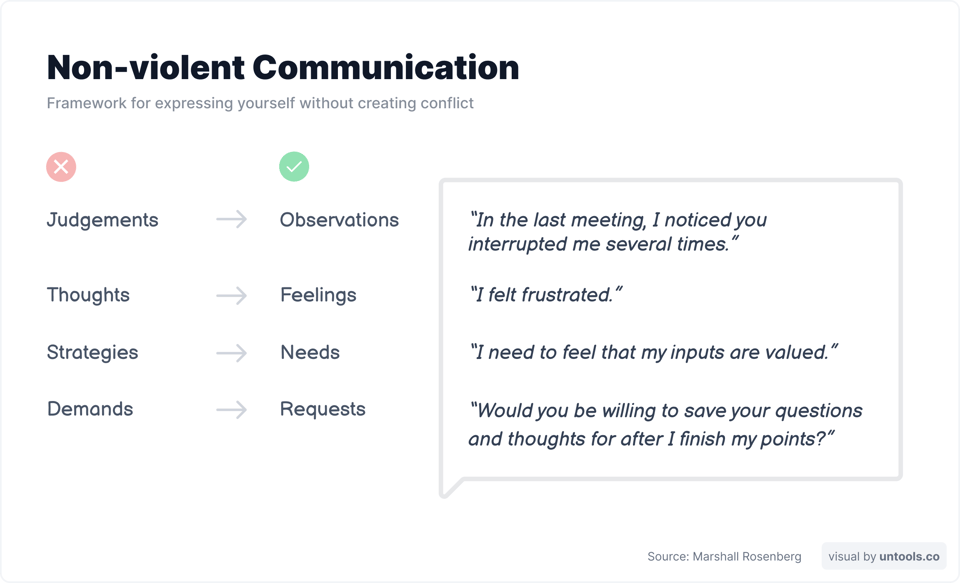How to have difficult conversations without conflict
Hi there, it’s Adam from Untools,
How do you express concerns, share difficult feedback or communicate your needs without making the other side feel too defensive? That’s a common communication problem that often leads to unnecessary conflict.
Today, we’ll look at Non-violent Communication: a framework for expressing difficult things while reducing conflict in everyday interactions.
When communication leads to conflict
Imagine a colleague approaches you and says: “You always interrupt me in our team meetings. You never let me speak properly.”
Hearing this, you’d sense their anger and perceive that communication as a threat, even if unconsciously. You’d get defensive and it would show in how you communicate back. Conflict is born.
When people feel a threat, they get defensive which prevents them from focusing on the message itself. It’s hard to tackle the problem when the exchange becomes “you versus me” instead of “us versus the problem”.
Liz Fosslien, co-author of the book Big Feelings, has a great illustration of this idea:

So how can we communicate in a way that avoids those unhealthy conflicts?
Non-violent Communication
Non-violent Communication (NVC) is a framework aimed at reducing defensiveness and inviting compassion. It was developed by a clinical psychologist Marshall Rosenberg in the 1960s. Rosenberg believed that people are compassionate by nature but this becomes obscured by communication patterns that go against it.
Rosenberg’s framework consists of four components that you can use to express yourself in a way that invites more compassion from others instead of making them defensive:
Observations
Feelings
Needs
Requests
In a review of research on using NVC among health professionals, this framework was shown to improve workplace relationships and that it can be used to reduce conflict and prevent aggressive situations.
How to apply it
You can follow the framework to start difficult conversations from a non-judgemental place.
1. Observations
Describe what you observed without any judgements or interpretations. Avoid generalisations and be specific about your observations.
Instead of “You always interrupt me”, you can say “In the last meeting, I noticed you interrupted me several times.”
Make sure you don’t disguise your judgement as an observation. For example “I noticed you were being rude.” is still a judgement.
2. Feelings
Express how what you observed made you feel. Again, it’s important to express just the feeling itself and not your interpretation of it.
“I felt frustrated” is better than “I felt like you don’t respect me” which is a thought with some judgement in it.
3. Needs
Say what you need. But not what you need from them (yet), but what you need as a person.
So instead of “I need you to let me finish”, you might say “I need to feel that my inputs are valued by the team.”
4. Requests
To invite collaboration, make a simple, actionable request that the other person can actually do.
For example: “Next time, would you be willing to save your questions and thoughts for after I finish my points?”
The key here is not to make your request sound like a demand (“Can you stop interrupting me?”) which can put people on the defence again.
Putting it all together
When we connect the examples from all four components above, this is how you might start a conversation using NVC:
“In the last meeting, I noticed you interrupted me several times. I felt frustrated because I need to feel that my inputs are valued by the team . Next time, would you be willing to save your questions and thoughts for after I finish my points?”

Why NVC works
Notice how the framework guides you to avoid judgement. Research shows that when people perceive being judged, they become defensive and stop listening to the actual message. Staying objective about your observations avoids that defensive response.
Even more importantly, avoiding judgement prevents you from perceiving the other person or what they’ve done as “bad”. Empathising with them and why they acted the way they did helps with not getting angry about it and communicating in a more compassionate way.
The framework also nudges you away from using “you” statements (which can often feel like accusations) to “I” statements to describe your experience. “You always interrupt me” forces people to defend themselves while “I felt frustrated when I was interrupted” just shares your experience.
Finally, putting feelings into words has been proven by research to have a positive effect on regulating our emotions. Saying “I felt frustrated” helps you stay level-headed in that difficult conversation.
When to use Non-violent Communication
NVC works best when both people are willing to engage and the conversation hasn't escalated into a conflict. It's designed to prevent defensive reactions when expressing yourself, not to diffuse situations that are already heated.
It's also less effective in contexts with significant power imbalances (like giving feedback to someone who reports to you) where the framework might feel forced or inappropriate.
Put it into practice
Next time you need to have a difficult conversation, spend a few minutes beforehand to go through this framework and prepare an opening statement using NVC. It should help make that conversation productive instead of creating a conflict.
Using NVC takes practice and it can feel awkward at first. Over time, using those four components (observation, feeling, need and request) to invite compassion will become a more natural part of your communication.
We’ve covered the basics of NVC here but there is much more to explore on this topic. Marshall Rosenberg's book "Nonviolent Communication: A Language of Life" goes much deeper into the framework.
If you found this useful, check out Untools Vault.
Vault contains practical toolkits for decision-making, problem-solving, facilitation, AI collaboration, and systems thinking. Each toolkit includes templates (PDF, Miro, Notion) and step-by-step guides with examples.
Lifetime access for one-time purchase, no subscription.
See what’s inside Vault →
Coming next: Decision-making under uncertainty
In the coming newsletter, we will look at decision-making when you don’t have all the information. We’ll explore strategies and tools for making good decisions with what you’ve got.
Until next time,
Adam
-
I wanted to say thanks for the amazing newsletter - it provides so much value that I will purchase Untools Vault even just for expressing my gratitude, and of course because I anticipate amazing thinkgins tools wating for me on the other side too!
Hats off to you!
Add a comment: